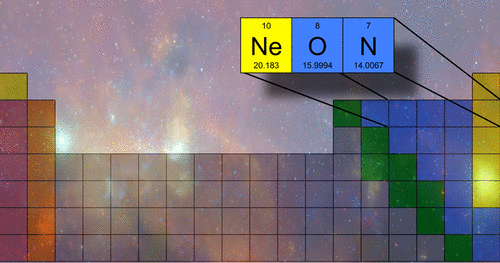当前位置:
X-MOL 学术
›
ACS Earth Space Chem.
›
论文详情
Our official English website, www.x-mol.net, welcomes your
feedback! (Note: you will need to create a separate account there.)
NeON+: An Atom and a Molecule
ACS Earth and Space Chemistry ( IF 2.9 ) Pub Date : 2018-03-22 00:00:00 , DOI: 10.1021/acsearthspacechem.8b00019 Ryan C. Fortenberry 1 , Steven R. Gwaltney 2
ACS Earth and Space Chemistry ( IF 2.9 ) Pub Date : 2018-03-22 00:00:00 , DOI: 10.1021/acsearthspacechem.8b00019 Ryan C. Fortenberry 1 , Steven R. Gwaltney 2
Affiliation

|
The NeON+ molecule is stable with a Ne + NO+ dissociation energy of 0.90 kcal/mol. While this is small, the two vibrational modes that include the neon atom are less than this barrier at 57.9 and 45.0 cm–1. Hence, this “L”-shaped molecule will not readily vibrate itself apart in cold environments, such as the interstellar medium, where the nitrosylium cation is believed to exist. While the 2359.2 cm–1 N≡O vibrational frequency is only slightly perturbed (but perturbed nonetheless) by the presence of the Ne atom, the other two fundamental vibrational frequencies will be observable in the terahertz region, where future space telescopes may operate. Furthermore, the curiosity of a stable molecule whose constituent atomic symbols spell the name of one such atom give this structure a unique place in the chemical imagination. Hence, “neon” is both a molecule and an atom.
中文翻译:

NeON +:原子与分子
NeON +分子稳定,Ne + NO +的离解能为0.90 kcal / mol。虽然这很小,但在57.9和45.0 cm –1处,包括氖原子在内的两种振动模式都小于该势垒。因此,这种“ L”形分子在寒冷的环境中(如认为存在亚硝鎓阳离子的星际介质中)将不易自行振动。而2359.2厘米–1N≡O的振动频率仅会因Ne原子的存在而受到轻微干扰(但仍会受到干扰),另外两个基本振动频率将在太赫兹地区观测到,未来的太空望远镜可能会在该太赫兹地区工作。此外,其组成原子符号拼写一个这样的原子的名称的稳定分子的好奇心使这种结构在化学想象中占有独特的位置。因此,“氖”既是分子又是原子。
更新日期:2018-03-22
中文翻译:

NeON +:原子与分子
NeON +分子稳定,Ne + NO +的离解能为0.90 kcal / mol。虽然这很小,但在57.9和45.0 cm –1处,包括氖原子在内的两种振动模式都小于该势垒。因此,这种“ L”形分子在寒冷的环境中(如认为存在亚硝鎓阳离子的星际介质中)将不易自行振动。而2359.2厘米–1N≡O的振动频率仅会因Ne原子的存在而受到轻微干扰(但仍会受到干扰),另外两个基本振动频率将在太赫兹地区观测到,未来的太空望远镜可能会在该太赫兹地区工作。此外,其组成原子符号拼写一个这样的原子的名称的稳定分子的好奇心使这种结构在化学想象中占有独特的位置。因此,“氖”既是分子又是原子。











































 京公网安备 11010802027423号
京公网安备 11010802027423号